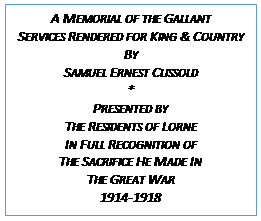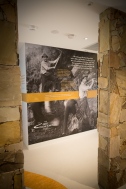 Lorne Obelisk
Lorne Obelisk
Location: 53 Mountjoy Parade, Lorne
In 1923 the Lorne RSL erected a stone obelisk dedicated to the residents who fought and died in World War 1 and has been added to for subsequent conflicts. Originally it was located near the library paddock (now Stribling Reserve) with a commemorative avenue of flowering gum trees adjoining it. To make way for a sports oval it was moved to the riverbank of the Erskine River, then again relocated near the swimming pool. Today it rests between the information centre and the sea baths.


Lorne State School – Honour Board & Roll of Honour Book
 Location: Honour Board – Lorne Senior Citizens Centre, Mountjoy Parade, Lorne
Location: Honour Board – Lorne Senior Citizens Centre, Mountjoy Parade, Lorne
Since the Gallipoli landing the Education department had stressed – ‘a roll of honour shall be compiled and displayed in every school of the state from which old boys have enlisted for service.’ In December 1918, the last school paper for all grades, the Education Department reiterated to all readers that the soldiers must not be forgotten. The directive was that the memorials should be of a permanent character and leave the impression that they are intended to last as long as the schools in which they are placed. The emphasis was on artistic honour rolls and not just of former pupils. Names of former pupils would be listed in a beautiful book worthy of its purpose, stored in a bookcase next to the honour roll. It was expected that the schools create their own book, putting it in a wooden case such as we have here.
Location: Lorne Roll of Honour Book – Lorne Historical Society, Mountjoy Parade, Lorne
Geelong Advertiser 8th December, 1917
A large number of the residents of Lorne assembled at the school on Wednesday, the 28th November, 1917 to witness the unveiling of the Lorne School honor roll. The school, which was crowded to excess, was decorated with flags, flowers and the portraits of the old scholars whose names were on the board. Mrs. T. Mountjoy performed the ceremony, after Kipling’s “Recessional” had been sung, the Rev. E. C. Frewin, Cr. Mount joy and Mr. Anderson gave short addresses. The board, which is a very handsome one of polished and carved blackwood, contains at present the names of 25 soldiers and one nurse; there are several more names to be added shortly. The proceedings terminated with the National Anthem, followed by cheers for the King and for Ptes. McLean, Romaro and Burrows, who were present.
Lorne Residents Honour Board
Location: Lorne Historical Society, Mountjoy Parade, Lorne
This Lorne honour board identifies the residents of Lorne and district who enlisted for active service abroad.
Shields
Location: Lorne Historical Society, Mountjoy Parade, Lorne
Presented to the families of these residents who were killed in action. Each shield inscription is




Commemorative Plaque

Location: Lorne Information Centre, Mountjoy Parade, Lorne
The commemorative plaque is one of a series of 15 by sculptor Dr Ross Bastiaan along the Great Ocean Road beginning at Torquay. The series of plaques honours the returned servicemen from World War 1 who built the Great Ocean Road as a tribute to their mates who died in the war. The inscription reads….The Great Ocean Road (GOR) was built as a living memorial to the Victorians who served in the First World War (1914-18). It was completed in 1932 and spectacularly opened the coastal areas to tourism and development.Although a coastal road was conceptualised for decades it was not until 1918 that a route was pegged and The Great Ocean Road Trust established. Funding was raised from the returned services league and local communities, as the state government was reluctant.The first section, Lorne to the Cumberland River, was begun in September 1919 but was so slow and underfunded that by 1920 community pressure had forced the relocation of the two work teams of 150 men each to the Lorne and Aireys Inlet section. The returned soldiers were well paid and lived in tents in a communal camp spirit reminiscent of their war years, as were the place names along the road.Lorne to Aireys was officially opened in March 1922. The single lane, unsealed road had a few guard rails and traffic was one-way during certain hours with a tollhouse at Grassy creek. As speed was limited accidents were rare.For the next decade, hundreds of men toiled in rugged, wild terrain building the road between Cape Patton and Lorne for The Trust and Cape Patton and Apollo Bay for the Country Roads Board (CRB). Huge geographical obstacles were gradually overcome in an era of ‘pick and shovel road construction’.AS the volume of traffic grew, widening and safety improved and the road was part metalled from 1934. The toll was removed in 1936 when the GOR Trust relinquished control to the State Government.Subject always to the elements, the GOR experiences road slippage and landslides whilst bush fires and annual seasonal threat. The road’s unrivalled beauty is a lasting tribute to the memory of those who served their nation in war and the 3000 men who built it.Lorne, 140 kilometres from Melbourne, is a favoured, fashionable tourist destination. The climate is moderate due ot the surrounding hills providing good shelter form the prevailing winds of Bass Straight.The nomadic Gadubanud Tribe were the traditional owners for over 40000 years.Loutit Bay, named after a local sea captain who sheltered there, has a spectacular one kilometre-sweeping beach. The town was named Lorne in 1871 after Queen Victoria’s son-in-law, the Marquis of Lorne.The coast was mapped in 1846 and limited farming soon followed. Subdivision occurred in 1869. Expansion began when more settlers built on the flattest areas around Erskine River where earlier in 1868 the Mounjoy brothers had a small temperance hotel that eventually became Erskine House Guesthouse. The building also held Lorne’s first church services and post & telegraph office. Around 1879 with a population of 150 the first Lorne pier, Grand Pacific Hotel and state school were opened.That same year Mountjoys and Cobb & Co. ran a six-hour coach service to Winchelsea rail station. When the railway came to Deans Marsh in 1891 the town progressed and further flourished with the opening of the Great Ocean Road in 1922.Timber milling existed for 120 years, the last mill closing in 1989. A fishing industry was established in the 1930’s greatly expanded after World War Two but declined by the 1980s. In 1958 bathing boxes lined the foreshore and groynes were built to stop beach erosion. By 1970 many guesthouse gave way to motels, whilst land prices soared.The annual 1.2 kilometres long ‘Lorne Pier to Pub’ swim started in 1981 and now attracts thousands as do new year festivities. The local beauty has inspired poets and writer, including Rudyard Kipling, and despite extensive commercialization, Lorne retains it’s charm.
Heritage Centre
Location: Lorne Information Centre, Mountjoy Parade, Lorne
Officially opened on November 26, 2014, the Great Ocean Road Heritage Centre tells the remarkable stories through historical displays and interpretive exhibits of the 3000 Australian ex-servicemen who helped build the world-renowned Victorian icon which is the world’s largest war memorial, constructed over 13 years to honour those who fought for Australia during the Great War.



